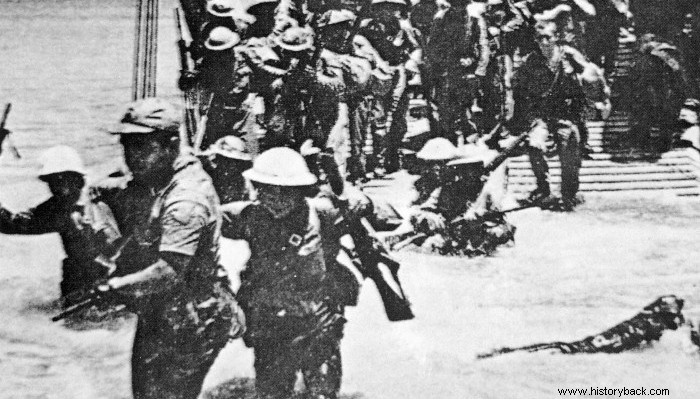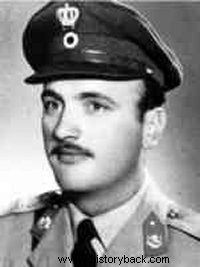
Pavlos Kouroupis was born in 1929 in Dentra, Messinia. He was a child of a rural, large family. His dream was to become an officer. He did it in 1952, graduating from the Evelpidon School. Very studious, he continued his studies and graduated from the School of Law of the Aristotle University.
He also excelled at the Advanced War School. At that time he married Maria Karvouni and had a daughter, Evangelia. In 1972 he was sent to Cyprus, where he took command of the 251st Infantry Battalion. He was at the head of his battalion on July 20 in Pendemili, facing the Turkish forces that were preparing to invade.
The night of July 19-20 was restless. At dawn some Turkish frogmen arrived swimming from a fast warship on the coast of Pendemilion. Their objective was to reconnoitre the coast, looking for minefields, sea or land. They found nothing. The Turks were noticed by a Greek patrol, whose men opened fire. The Turks withdrew without loss.
In the meantime the Turkish flotilla was approaching the coast. According to the plan, the landing would take place on the coast of Pendemilion. The Turks initially, however, were mistakenly directed to another point. So the landing scheduled for 05:30 started at 07:20. From 05:15 the Turkish Air Force began heavy bombing of military as well as political targets mainly in the Kyrenia-Nicosia region.
At 06:00, paratroopers began dropping to reinforce the Nicosia enclave (Kioneli). At the same time, Turkish commandos were being transported to Agyrta by helicopters, which, according to testimonies, were refueled on the British aircraft carrier "Mercury", which, "completely by chance", was patrolling off Cyprus that morning.
Turkish airstrikes continued throughout the day. At Pendemili, a platoon of the 2nd Company of the 1st Marine Battalion was initially landed. The Turks met no resistance. Thus the whole battalion disembarked, without any disturbance. Then forces of the 50th Infantry Regiment began to disembark, with M-113 TOMBs and an Artillery squadron.
Opposite the Turkish forces was, as mentioned, only one Greek battalion with a reduced composition, the 251 TP, led by lieutenant colonel Pavlos Kouroupis. 251TP was ordered to deploy to Pendemili only at 07:00. But the problem was that at the rear of the battalion's positions was the Turkish Cypriot village of Templos, the extreme limit of the Turkish Cypriot enclave of Nicosia-Agyrtas-Templos.
So Kouroupis was obliged to allocate part of his forces in this direction. Against the bridgehead he deployed only the 1st Company and the Support Company (heavy weapons company). In these small forces he also assigned men of the commanding company, clerks, cooks and some extra-soldiers who had arrived in the meantime. The GEEF also placed under its command an ulama with 5 T-34 tanks.
The two Greek companies faced a regimental force, which supported the Artillery and the guns of the warships, not to mention the Air Force. Despite the difficulties, the Greek divisions opened fire pinning the Turks in a zone 350 meters wide and 1,000 meters long on the coast. Unfortunately the Greek Artillery did not participate in the battle.
The 182nd Field Artillery Squadron able to attack the bridgehead did not fire, awaiting orders to do so. He finally opened fire when he perceived the struggle of the companies of 251 TP. Even worse, the 198th Mountain Artillery that was stationed on the commanding hill of Prophet Elias never opened fire.
The Greek weaknesses were quickly noticed by the Turks, who gradually began to attempt to widen the bridgehead. The first attempt was repulsed by the men of 1/251 Company. However, under the pressure of the strong Turkish forces, the two Greek companies were forced to shrink slightly.
On the coast, Kouroupis with his 250-300 men was still holding 3,500 Turks of the "Cakmak" Landing Brigade pinned down. Fortunately, the Turks did not manage to land on the coast the island of M-47 tanks intended to reinforce the brigade.
The Battalion, according to the plans, was to be immediately reinforced by the enlisted 3rd Tactical Group (306 and 316 Enlistment Battalions). In these critical hours, the 3rd Tactical Group did not manage to reinforce the fighting 215 TP. The 306 TE was actually never formed and only one division was formed from the 316 TE.
The situation for the Turks changed at Pendemili with the arrival of the commander of the 39th Infantry Division Major General Demirel, who managed to put some order and organize the next movements of the disembarked forces.
Time was pressing for the Turks. At 11:00 the Turkish forces moved towards their original ANSK, i.e. Kyrenia. Opposite them were the exhausted two companies of the heroic 251 TP, which had been fighting continuously for two days, and some soldiers of the 306 TE in Kyrenia itself. About 150 commandos of the 33rd Commando Squadron were added to these forces.
The other reinforcements that the GEEF intended to send, which included the 120th Heavy Weapons Company, the only Greek unit with serious anti-tank weapons (Soviet guided A/T missiles) did not arrive. The commandos took positions on the side of the 251 TP, where they were supposed to meet the 306 TE, which had arbitrarily retreated to Kyrenia.
The commandos were elite, but they had neither serious nor enough anti-tank weapons. And the Turks attacked directly against them, simply hooking the other Greek divisions. The outcome of the battle was predictable. Despite a heroic and bloody fight, the commandos were forced to retreat. Their lines broke and individually the men began to retreat towards Kyrenia. The men of 251 did the same, who were in danger of being surrounded.
The retreating divisions had no hope of holding the city. Nevertheless, they fought bravely and sacrificed. This was also the case of lieutenant colonel Pavlos Kouroupis, the deputy commander of Major Tsiakkas and the captain of commandos Nikolaos Katoundas. Shortly before entering Kyrenia, Kouroupis' group consisting of 11 men and Major Tsiakkas, were surrounded by a company of Turks, and immediately the battle began.
Kouroupis, Smith &Wenson in hand, ordered his men to break the deadly circle at a small stream to the east, which the Turks had not yet reached. They refused to leave him. Then he ordered them to leave. And only then these lads excitedly decided to leave. But their commander and deputy commander remained to cover them. "As the soldiers were leaving, they could hear the shots from the area where the two Greek officers stayed, slowly thinning out until they were completely silent" (narration of a rescued soldier).
Lieutenant Colonel Pavlos Kouroupis has been missing since then, along with Major Tsiakkas. On March 27, 1995, the journalist Petros Kasimatis revealed to the newspaper "Eleftheros Typos" the most shocking document up to that time.
The EYP had identified, through a Greek colonel who pretended to be a fishmonger, six missing persons in Bolu, Turkey, and another seven in Denizli. The colonel, named Yiannopoulos, spoke briefly with the first group after bribing the jailers. All of them were in a miserable condition.
One of them was Pavlos Kouroupis. According to Kasimatis, the EYP organized an operation to free them, during which a man was killed in an exchange of fire with the Turks. Since then the traces of the heroic lieutenant colonel have been lost.

Pavlos Kouroupis.
